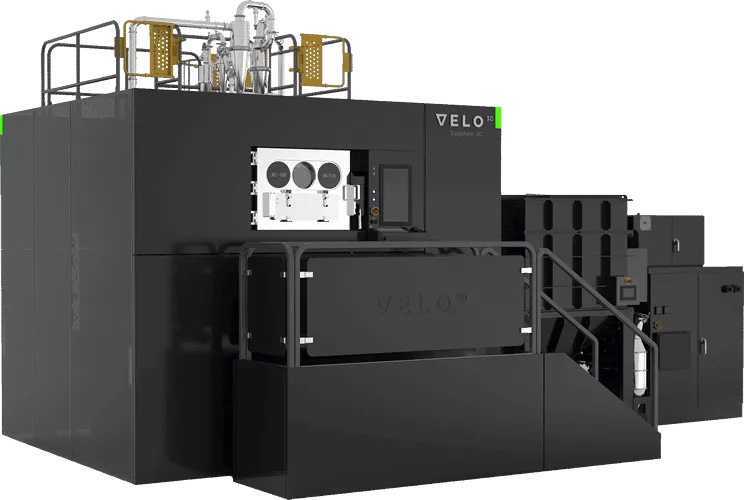As additive manufacturing (AM) shifts from low volume to scale, speculation has mounted about how long it will take until AM is ready for use in mass production. This is especially true regarding metal AM, considering its potential for streamlining the manufacture of the most complex components in heavy industry’s highest value products.
While the performance of some incumbent metal AM systems remains fragmented, making standardization difficult, overall progress in the qualification of metal materials for AM applications has increased significantly over the last several years. One company responsible for commercialization of such progress, Velo3D, recently released a white paper illustrating the real impact that AM can make on automotive tooling – an indirect entry into the mass production market.
This can be seen in a wide range of contexts, though the focus of the Velo3D white paper — inserts for die casting — is an area that’s particularly ripe for metal AM. A future post will outline how Velo3D’s fully integrated metal AM solution, specifically, is optimized to meet the challenge of printing metal die cast inserts. Here, I’ll begin to explain how metal AM is harmonizing with conventional manufacturing methods to accelerate the die casting process in automotive mass production.

The white paper, titled “How Additive Manufacturing is Transforming Tooling”, introduces its central topic by way of the term “AM-enabled conventional manufacturing”. While I was unfamiliar with the phrase, I instantly grasped the concept it refers to, given the growing use of 3D printing for that purpose, above all, in areas like aerospace, energy, and automotive. The gist is that by using AM to produce tooling components, manufacturing operations can both accelerate output of end-use parts, and implement design and performance features that would be impossible with traditional methods.
Die casting involves the pouring of molten metal into two molds (“dies”) and waiting until the metal fully cools. When the part cools and thereby solidifies, pins eject the finished product. That aspect – fully cooled metal – is the key to the whole process, and for it to happen at the speed required for mass production, die cast inserts tend to use, as part of their design, cooling channels, into which coolant is injected, to accelerate the drop in temperature and solidification.
Since the metal can only be ejected after every section of the part is solid, the last section to cool delays the entire operation. According to Velo3D, waiting for the die cast insert to cool down makes up around 70 percent of the manufacture time for a die casted part. This, then, is clearly the phase that needs to be targeted for accelerating the production process, and even the smallest measurable gains here could ultimately have an aggregate impact. That explains why the optimization of cooling channels is so singularly consequential.

However, there is a hard limit to how much can be done on that front with conventional manufacturing methods. Traditional cooling channels are typically drilled into the die in straight lines with 90 degree intersections. This limits the geometric options to deliver the cooling fluid and creates crack initiation sites at the intersections.
Metal AM solves both problems: cooling channels can be printed within the structure of die cast inserts that can then be added to the larger die patching areas with the longest cooling times with a section that can bring coolant to the optimal point. They can be designed into shapes that allow coolant to reach areas of a part that take the longest time to solidify, or sections where the material properites are critical to maintain. These are known as “conformal cooling channels”, and are one of the big success stories of AM’s entry into the end-use part landscape.
At the same time, not every metal AM platform is up to handling that task, though some are suited for it perfectly. In particular, the Velo3D Sapphire XC, backed by the company’s fully integrated proprietary software platforms, is just the machine for the job. Again, that will be explained in a future post, but anyone interested in finding out for themselves can download the white paper here.
Images courtesy of Velo3D
Subscribe to Our Email Newsletter
Stay up-to-date on all the latest news from the 3D printing industry and receive information and offers from third party vendors.
You May Also Like
Precision at the Microscale: UK Researchers Advance Medical Devices with BMF’s 3D Printing Tech
University of Nottingham researchers are using Boston Micro Fabrication‘s (BMF) 3D printing technology to develop medical devices that improve compatibility with human tissue. Funded by a UK grant, this project...
3D Printing Webinar and Event Roundup: April 21, 2024
It’s another busy week of webinars and events, starting with Hannover Messe in Germany and continuing with Metalcasting Congress, Chinaplas, TechBlick’s Innovation Festival, and more. Stratasys continues its advanced training...
3D Printing Webinar and Event Roundup: March 17, 2024
It’s another busy week of webinars and events, including SALMED 2024 and AM Forum in Berlin. Stratasys continues its in-person training and is offering two webinars, ASTM is holding a...
3D Printed Micro Antenna is 15% Smaller and 6X Lighter
Horizon Microtechnologies has achieved success in creating a high-frequency D-Band horn antenna through micro 3D printing. However, this achievement did not rely solely on 3D printing; it involved a combination...





























